
Subscribe & stay up-to-date with ASF

For those out on the rivers, also send along anecdotal information on the situation – remembering to give locations. There have continued to be some good reports coming in, even where water is low.

Keagan Bird proudly watches the fish he caught this morning at Kedgwick Lodge as his dad Andrew carefully releases it back to continue on it’s journey upriver. Keagan’s fly of choice was a special version of a Green Machine tied by his Grandfather Danny Bird. Photo Danny Bridgde
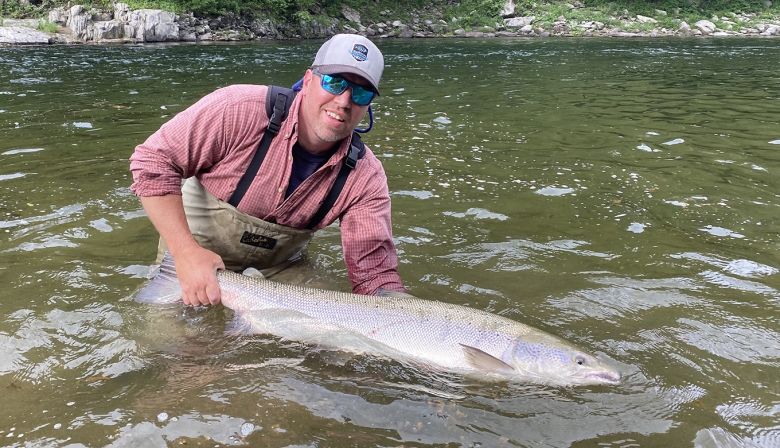
Nathan Wilbur, ASF Director of New Brunswick Programs, says:
Positive reports continue to stream in from both the Restigouche and the Miramichi, despite the lack of rain and challenging water conditions for fish and anglers. We’re finally getting rain this week which should continue to bring fish into the rivers and keep them moving upstream – and cool things off in the rivers. The Northwest Miramichi barrier numbers are encouraging with about 3 times more fish than last year to the same date. The Dungarvon barrier numbers are improving with what appears to be a strong run of grilse.
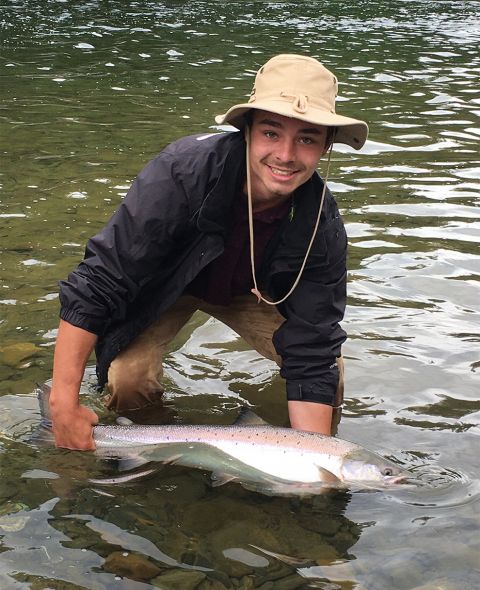
From anecdotal reports, anglers are enjoying not only the best run of grilse we’ve seen in a few years, but also good numbers of large salmon. This is consistent with reports from elsewhere like Newfoundland, so it appears that overall sea survival was better last year than in recent years. That’s great news and hopefully it continues. Unfortunately, many of the counting facilities normally run by DFO are not in operation this year so some rivers will have no assessment. However, the counting programs run by provinces and NGOs will provide a good indication of run strength this year.

Brock Curtis of Curtis Miramichi Outfitters in Blackville says:
Good news here on the Miramichi. Reports of fresh salmon moving into the Miramichi River system. These reports were coming into the tackle shop prior to last Friday but over the weekend with the full moon, the numbers seemed to increase.
By Sunday some anglers were limiting out and having to hang up their rods. Almost everyone are finding salmon here on the lower section of the Miramichi in the Blackville area.
Heavy rain today can only help the angling and anglers are still reporting good fishing.
I cain’t imagine what the reports would be if the cold water pools were open which is the main topic of conversation among anglers and folks living along the river. Many feel the pools should be open, and hopefully they will change status soon.
Most of the salmon caught were hooked on wet flies, and not hearing of much action on the dry flies yet.
Northwest Miramichi Barrier
For a barrier only installed June 15, 2020, the results have been stunning – stunning good that is.
With 92 large salmon and 37 grilse vs. last year’s 19 large and 25 grilse, this is being exceptional, even with the warm water.
Notes from the Kedgwick River in the Restigouche System
Danny Bird, Manager of Kedgwick Lodge notes:
There appears to be a great run of fish on the Restigouche. Grilse seem fat and well fed. There is also a major component of large fish in the river. A good rain overnight on Tuesday gave the water a much needed refreshing and in speaking for the section we have it seemed to give all the pools a new assortment of fish.
We do notice some dead fish floating down the Kedgwick. One was extremely large and barely moving. This salmon was noticed dead several pools below where we first observed it. I can only assume it was overplayed by an angler above on the Daily Crown.
Viewers need to take great care with the warmer waters and not overplay fish.

While numbers had been low, they are coming up. To July 5 there were 29 grilse and 18 large salmon, compared with 16 grilse and 36 large salmon. However, as Brock Curtis points out, there has been an influx in past few days, so we will see how the Dungarvon tributary does in the next few weeks.

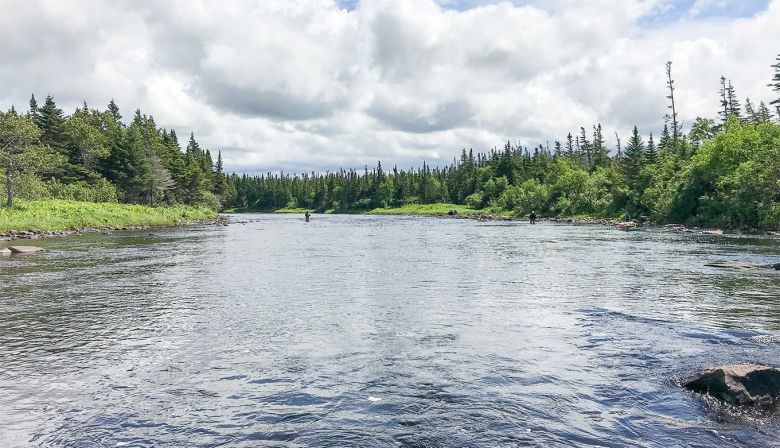
Don Ivany, ASF Director of Programs for Newfoundland and Labrador, provides an update on Atlantic salmon in the province:
The good fishing continues
Reports from anglers throughout Newfoundland and Labrador during the past week indicate that runs continue to be strong and fishing has ben great on most rivers, with the exception of a few areas where low water levels and warm water temperatures are starting to become an issue.
While we can definitely use a good dowsing of rain on most rivers to freshen things up, the night-time air temperatures have been cool, thus helping to moderate water temperatures, and preventing rivers from closing. In other good news,
DFO’s Science Division has received a green light from their department to install counting facilities on rivers throughout NL (see notice at the end of this report), and technicians have been busy this past week doing just that. Fences have been installed on Western Arm Brook and Corner Brook Stream and more are being installed as we speak. DFO has also posted data up to July 5 on a select number of counting facilities that have been in operation under contract for the past few weeks. Overall, the numbers are encouraging compared to the numbers for the same weekly time period last year. This data can be accessed at the following link:
http://www.nfl.dfo-mpo.gc.ca/nl/salmoncounts
Also, with the recent approval of the Maritime Covid-19 ‘bubble’, which now permits interprovincial travel between the four provinces, non-residents anglers from the Maritime Provinces are now able to travel to NL to fish, and have already started doing so. This is welcome news for the outfitting industry and other small business operations that benefit significantly from their presence in NL.

Southwest Newfoundland:
A few rain showers in this area late last week followed by cooling air temperatures allowed these rivers to remain open. While fishing conditions were less than ideal there was still a good sign of fish on most of these rivers. Fish were being caught on Harry’s River and Fischelles River, and there were some excellent reports from the lower section of Crabbes River, indicating fresh fish were still coming in.Western Newfoundland:
Water levels on the Humber River were near perfect for the past week and anglers were enjoying good success despite a few warm days in the middle of the week. However, cool air temperatures at night have been helping to moderate water temperatures and more rain is in the forecast starting on the week-end.
Don Ivany continues with his report:
Northern Peninsula: Most reports from anglers on the Northern Peninsula last week indicate that fishing was excellent on these rivers at the time.
Torrent River and River of Ponds were a little high to start the week but both were fishing well and producing a good mix of grilse and large salmon according to angler, Kirk Beverley.
Both the Castor River and St. Genevieve Rivers had excellent water conditions during the early part of last week and produced good numbers of grilse and large fish at the time. I was on vacation last week and enjoyed excellent fishing on the Castor River and there was a good mix of both large fish plus some chunky and feisty grilse.
A three-day heat wave during the middle of the week saw water levels drop quickly and increasing water temperatures reduced angling success. This was followed by a day of steady rain and cool night temperatures that improved conditions and led to excellent fishing again on July 02 and 03. But by this past weekend low water levels and warm water temperatures had slowed fishing again. These rivers could use some rain, and fortunately there is a little in the near forecast.

Eastern Newfoundland:
While water levels are low on most east coast rivers at the moment, and water temperatures are on the warm side, anglers are still reporting a good sign of fish in most rivers. Early morning fishing when water temperatures are coolest seems to be producing the best success.Dwight Lethbridge
from Pratt Falls Lodge reports a good start to the season on the Eagle River as of July 4 with a nice mix of grilse and large salmon. Water levels are still a bit high but are dropping gradually and more fish are being seen and hooked on the river with each passing day.Note
: we are still waiting for first reports from rivers in Northern Labrador. The following is a note from DFO about their Atlantic salmon counts in 2020:Jul. 6, 2020
2020 Atlantic Salmon Counting Fences and Fishways
Fisheries and Oceans Canada (DFO) Science have posted Atlantic salmon counts up to June 28, 2020 from counting fences and fishways that are currently in operation. Some counts will be added in the coming weeks as additional counting fences are installed and operational.
Please note that monitoring activities at some of our facilities have been affected by the COVID-19 public health emergency. Due to delayed installation of some counting fences and opening of monitoring sites, salmon counts to date on some rivers may appear lower than in previous years in cases where fish moved upstream prior to installation of counting facilities. DFO Science will review the 2020 data after the angling season to determine the effect of these delays on salmon counts.
See the salmon counts at:

Margaree
Greg Lovely writes:
I drove along the river today and there are some fishermen around, but certainly not the numbers there were last week.
The river levels from the Forks down are not too bad and thank goodness for cool nights and day temperatures that are not getting too much above 15 C.
It seems from the radar, that all the rain is by passing Cape Breton’s western shores leaving us with a sprinkle now and then. The Northeast Branch remains extremely low. Here are a few pictures I took of On the Lower part of the river salmon were showingm but were not the least interested in taking a fly. I watched a couple of fishermen throwing quite an assortment of wet and dry flies until
they conceded it was “Miller time”.

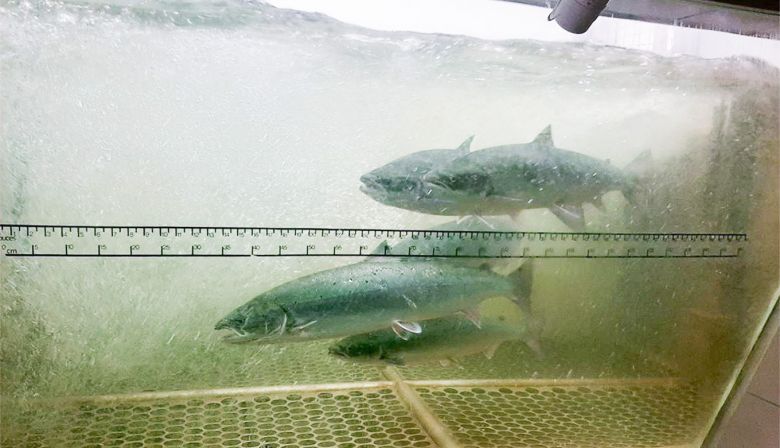
In general, at the time this report is being written angling is reported to be very good to great with water levels still very much on the low side.
Returns are also very encouraging to date, The Matane River attained the 1,000 fish mark through the fishway on July 7th, almost 2 to 3 weeks sooner than normal. In 2011, which was a great season, the 1,000 fish mark was reached on July 27th.
Of interest to many river managers and all anglers is the sized of the grilse run this year. The last three years have not been productive on that front.
Reminder to anglers fishing Quebec Rivers: take the time to report your releases in order to have the most accurate angling statistics and for the river managers to accurately calculate angling success.
All data presented in this report is sourced from individual river web sites, social media accounts and are regulated by the Quebec wild Atlantic salmon management plan.

Salmon and grilse are to be counted during the weekend of July 11-12 to ascertain abundance, water conditions permitting.
The York, like the two other rivers of Gaspé are in desperate need of rain. As of July 7, following some precipitation, the water flow recording station located 1.4 km downstream from Dinner Island Creek indicated a flow of 14 cubic meters per second.
As of June 30th, 245 fish (salmon and grilse breakdown not available) have been landed and released. The vast majority in 2020 are large salmon.
To June 30, 2019, 174 fish had been reported landed (170 salmon released, 2 grilse released and 2 grilse killed.
To June 30, 2018, 62 fish had been reported landed (60 salmon released, 1 grilse released and 1 grilse killed.

As of June 30th, 111 salmon and grilse have been reported landed. The vast majority being large salmon.
To June 30, 2019, 100 fish had been reported landed (91salmon released, and 2 grilse killed.
To June 30, 2018, 43 fish had been reported landed (36 salmon released and 7 grilse killed).

Saint-Jean River (Gaspé) Season opened on May 25 (does include St-Jean Lodge captures)
At June 30th, 71 fish have been reported landed. The vast majority being large salmon that were released.
To June 30, 2019, 46 fish have been reported landed (37 salmon released and 9 grilse killed).
To June 30, 2018, 18 fish had been reported landed (14 salmon released and 4 grilse killed).
Bonaventure River anglers are reporting an improvement in the angling success to July 4th. To date for the season, 278 fish which includes 159 salmon have been landed and released. As opposed to the same date last year where a total of 135 fish (107 salmon) were released.
On the Matapedia, the CGRMP reports 325 fish (272 salmon released and 53 grilse harvested) to July 6. At the same date in 2019, 252 fish had been landed including 202 salmon released.

The Cascapedia is continuing its very hot pace to date with many large 3SW salmon being landed as well as a good run of 2SW salmon. Official statistics from the Cascapedia society should be available next week for the month of June. In the mean time, check out the Micmac Camp FB page:
https://www.facebook.com/Micmac-Camp-199352133438454/
Anglers on the Madeleine River are very upbeat with the number of fish that have been counted through the fishway to July 7th, 301 large salmon and 140 grilse. 110 fish (90 salmon and 20 grilse) had been counted at the same date in 2019.
Good news continues to be reported from the Mitis River, where the new fish trap seems to be surpassing expectations. To July 8th, 694 fish have been transported upriver (446 large salmon and 248 grilse). Anglers have released 31 large salmon and harvested 22 grilse. These results are very encouraging considering as of July 23rd, 2019, a total of 558 fish had been counted (299 large salmon and 257 grilse).
The peat coloured Rimouski is also performing well to date. As of July 6th, 65 large salmon and 10 grilse have been counted. In 2019 to that date, 47 large salmon and 13 grilse had been counted and transported up stream.
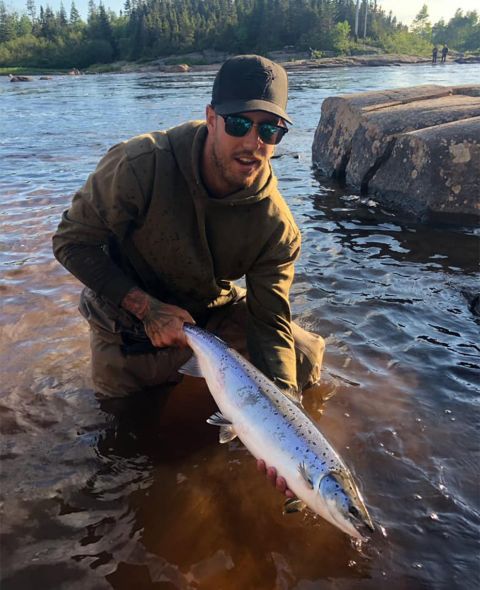
À ce jour, la rivière Matane a franchi la barre des 1 000 poissons le 7 juillet, 2 à 3 semaines plus tôt que la normale. En 2011, une saison d’abondance quasiment record, le cap des 1 000 a été atteint le 27 juillet.
Ce à quoi ressemblera le dénombrement de petits saumons cette année est d’intérêt aux pêcheurs et les gestionnaires des rivières. Les 3 dernières années ont démontré une baisse d’abondance marquée pour les saumons qui ont passé un an en mer.
Un rappel aux pêcheurs des rivières du Québec, prenez le temps d’enregistrer vos remises à l’eau afin d’avoir des statistiques de pêche les plus précises et pour l’important calcul du succès de pêche.
Toutes les données présentées dans ce rapport proviennent de sites Web de rivières, de comptes de médias sociaux et sont assujetties au plan de gestion du saumon atlantique du Québec.
Rivière York
Si les conditions d’eau le permettent, un décompte devrait être effectué pendant la fin de semaine du 11 au 12 juillet afin de vérifier l’abondance de la ressource. Ceci en prévision de permettre la récolte de grand saumon à partir du 15 juillet. Pour l’ensemble des rivières au Québec, les pêcheurs doivent attendre au 1er aout avant de pouvoir récolter un grand saumon.
Cumulativement au 30 juin, 245 prises (ventilation saumon et petits saumons non disponibles) ont été déclarées.
Au 30 juin 2019, 174 prises avaient été déclarées (170 saumons relâchés, 2 petits saumons relâchés et 2 petits saumons récoltés)
Au 30 juin 2018, 62 prises avaient été déclarées (60 saumons relâchés, 1 petit saumon relâché et 1 petit saumon récolté.
Rivière Dartmouth
Au 30 juin cumulativement, 111 prises (ventilation saumon et petit saumon non disponible) ont été déclarées.
Au 30 juin 2019, 100 prises avaient été déclarées (91 saumons relâchés et 2 grils récoltés).
Au 30 juin 2018, 43 prises avaient été déclarées (36 saumons relâchés et 7 petits saumons récoltés).
Rivière-Saint-Jean (Gaspé), ne comprends pas les captures du pavillon Saint-Jean)
Cumulativement au 30 juin, 71 prises ont été déclarées (ventilation saumon et petit saumon) non disponibles.
Au 30 juin 2019, 46 prises avaient été déclarées (37 saumons relâchés et 9 petits saumons récoltés).
Au 30 juin 2018, 18 prises avaient été déclarées (14 saumons relâchés et 4 petits saumons récoltés).
Les pêcheurs de la rivière Bonaventure signalent une amélioration du succès de la pêche au 4 juillet. À ce jour pour la saison, 278 prises, dont 159 saumons, ont été relâchées. Comparativement à la même date l’an dernier où un total de 135 prises (107 saumons) avaient été relâchées.
Sur la Matapédia au 7 juillet, la CGRMP signale que les pêcheurs ont déclaré 325 prises (272 saumons relâchés et 53 grils récoltés). À la même date en 2019, 256 saumons et grils avaient été déclarés, dont 202 saumons relâchés.
La Causapscal a connu un début de saison fulgurant, mais a ralenti en raison des niveaux d’eau et des températures d’eau chaudes. Cumulativement au 6 juillet, 127 prises ont été signalées dont 53 saumons relâchés. La saison dernière au 6 juillet, 156 prises avaient été déclarées, dont 97 saumons relâchés.
La Cascapédia continue sur sa lancée à ce jour avec de nombreux grands saumons (3 ans de mer) ainsi qu’une bonne montaison de saumons (2 ans de mer). Les statistiques officielles de la société Cascapedia devraient être disponibles la semaine prochaine pour le mois de juin. En attendant, consultez la page FB du Micmac Camp sur https://www.facebook.com/Micma… pêcheurs de la rivière Madeleine sont très optimistes considérant le nombre de poissons qui ont été dénombrés dans la passe à poissons jusqu’au 7 juillet, 301 grands saumons et 140 petits saumons.
À pareille date en 2019, 110 poissons (90 saumons et 20 petits saumons avaient été dénombrés.
Les plus récentes nouvelles de la rivière Mitis continuent d’être encourageantes. Le nouveau piège à saumon semble dépasser les attentes à ce jour au 8 juillet, 694 poissons ont été transportés en amont (446 grands saumons et 248 petits saumons). À ce jour, les pêcheurs ont relâché 31 grands saumons et récolté 22 petits saumons. Ces résultats sont très encourageants étant donné qu’au 23 juillet 2019, un total de 558 poissons avaient été dénombrés (299 grands saumons et 257 petits saumons).
La Rimouski se comporte également bien à ce jour. Au 6 juillet, 65 grands saumons et 10 petits saumons ont été dénombrés. En 2019 à cette date, 47 grands saumons et 13 petits saumons avaient été dénombrés et transportés en amont.

Penobscot
Jason Valliere, Biologist with Maine DMR, says:
We are still seeing good numbers of salmon at the Milford lift.
Salmon count is up to 1,298 That surpasses last year’s estimate. A total of 1,120 fish have been released to the river. Of the 1,298 fish approximately 1,178 of those fish are Multi Sea-Winter fish and 120 are 1 Sea-Winter fish. 178 fish (157 MSW and 21 Grilse) have been sent to Craig Brook National Fish Hatchery for broodstock.
Temperatures continue to fluctuate such that we are having periods of time where gates are open for free passage (video count) and days where it’s cool enough we can close them for Brood Stock Collection. Counts not been adjusted for in-season recaptures based on PIT Tag, Radio Tag, or proration. Counts will be adjusted as data become available.
A few fresh shad continue to trickle in.
We also had another visitor to the trap this week. This sturgeon was tagged and released back to the river by UMO.
